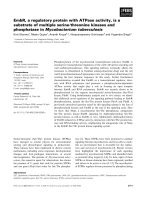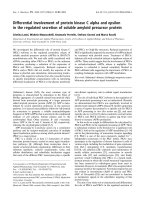Capacity for delivery services of non communicable diseases prevention and management in commune health centers 2014
Bạn đang xem bản rút gọn của tài liệu. Xem và tải ngay bản đầy đủ của tài liệu tại đây (392.81 KB, 6 trang )
78
Long et al. / VJPM 2016; XXVI, 3(176): 78 - 83
Capacity for delivery services of non-communicable diseases
prevention and management in commune health centers, 2014
Nguyen Hoang Long1* and Ngo Tri Tuan2
School of Medicine and Pharmacy, Vietnam National University, Hanoi, Vietnam
Institute for Preventive Medicine and Public Health, Hanoi Medical University, Vietnam
1
2
Abstract
This study aimed to describe the current available and readiness of resources of commune health centers (CHCs) in
selected areas in Vietnam for the prevention and control of diabetes and hypertension in 2014. A cross-sectional study
was conducted on 90 CHCs in Hoa Binh, Ha Tinh and Kien Giang provinces. Service availability and readiness
assessment (SARA) instrument was used to assess the capacity of CHCs. The results showed that most of CHCs
achieved <70% of standards for diabetes diagnosis and management (83.3%), especially in difficult-to-reach areas
(97.8%). Meanwhile, the proportion of CHCs having sufficient capacity for hypertension service delivery was high.
Most of CHCs reached from 70% to <100% of standards for hypertension management and treatment (59.8%). The
results suggested that enhancements and investigations in equipment and capacity of CHCs should be implemented,
particularly in remote areas.
Keywords: Delivery service, non-communicable diseases, commune health centre, SARA
1. Introduction
Non-communicable diseases (NCD) are leading
causes of mortality worldwide, especially
in low and middle income countries [1].
Additionally, NCDs raise serious implications
for the development of each country due to the
loss of productivity and financial burden for
families and societies [2]. To respond, World
Health Organization has stated an action plan
to promote the role of primary health care to
NCD prevention and control [1]. Therefore,
ensuring the essential resources in grass-root
health care level is necessary to implement
successfully this strategy.
Vietnam’s disease pattern is undergoing an
epidemiological transition, from communicable
diseases to NCDs. According to recent estimation
in 2010, NCDs contributed to two third of disease
burden in Vietnam [3]. The hospital admission
due to NCDs significantly increased from 39.0%
in 1986 to 66.2% in 2008, while the mortality
increased from 42% to 63.3% during this period
[4]. In order to address the NCD epidemic, a
national program for NCDs prevention and
control has been performed with the support
from some central and specialist hospitals in
Vietnam (such as Vietnam Heart Institute,
National Cancer Hospital etc.). Besides, Ministry
of Health also implemented an integrated
approach at commune health centers (CHCs),
which serve as the access point of healthcare for
the majority of patients having NCDs.
With the crucial role of CHCs in preventing
and managing NCDs, strengthening the
capacity of CHCs should be prioritized to serve
the need of population. In order to provide the
evidence of available resources in CHCs for
NCDs, especially some common diseases such
as diabetes and hypertension, this study aimed
to describe the current available and readiness
of resources of CHCs in selected areas in
Vietnam for the prevention and control of
diabetes and hypertension in 2014.
* Corresponding author: Nguyen Hoang Long
School of Medicine and Pharmacy, Vietnam National University, Hanoi, Vietnam
Tel: +84.983297654
Email:
Received 08 December 2015; In revised form 16 February 2016; Accepted 14 March 2016
Vietnam Journal of Preventive Medicine
Long et al. / VJPM 2016; XXVI, 3(176): 78 - 83
2. Materials and Methods
Subjects
Health facilities and staff of the CHCs were studied.
Study settings
The study was conducted in three provinces
of Hoa Binh (represents Northern regions),
Ha Tinh (represents Middle regions) and Kien
Giang (represents Southern regions) from June
to December 2014.
Study design
A cross-sectional study was conducted.
Study sample size and sampling technique
In this study, a Bailey’s formula (1982) to
calculate the size of organization sample in a
quantitative study was applied, with 30 as the
minimum sample [5]. To compare the difference
among rural, urban and difficult-to-reach areas,
we multiplied the minimum sample by three. A
total of 90 CHCs were enrolled in the study.
A multi-stage sampling technique was used.
A list of districts from 3 targeted provinces was
categorized in rural, urban and difficult-toreach groups. Then, in one group, three districts
in one province were randomly selected. A total
of 9 districts was recruited (Hoa Binh province:
Ki Son, Hoa Binh city and Luong Son; Ha Tinh
province: Huong Khe, Ha Tinh city and Thach
Ha; and Kien Giang province: Rach Gia city,
Hon Dat and An Bien). Finally, in each district,
ten communes with their CHCs were randomly
recruited to participating in the study.
Measurements
Master students and staffs working at the faculties
of Hanoi Medical University were selected and
well-trained in data collection team. A structured
questionnaire was used to collect reported
information of CHCs (socio-economic status of
commune, human resources, equipment, facility,
guideline, service provided, etc).
Service availability and readiness assessment
– SARA instrument was applied to measure the
availability and readiness of NCD prevention
79
and management services in CHCs [6]. The
assessment of service availability comprises
both general and specific components. In this
study, we focused only on the service-specific
availability and readiness of essential resources
for diabetes and hypertension management,
treatment and prevention. Service-specific
availability focuses on whether a specific type
of health intervention is offered, while servicespecific readiness reflects the capacity of health
facilities to provide interventions in key program
areas. The essential inputs needed to deliver
service-specific interventions are described in four
domains: (i) trained staff and relevant and up-todate guidelines; (ii) functioning equipment; (iii)
diagnostic capacities; and (iv) essential medicines
and commodities. A total of 11 tracer items were
investigated for each disease. All tracer items are
given equal weight with one score, summing to a
total of 11 score. Those components were assessed
in three levels: <70% of standard (if score is < 8),
from 70% to 100% (if score is from 8 to 10) and
100% of standard (if score is 11) [6].
Data analysis
The data was entered using Epidata software
version 3.1 and analyzed by STATA software
version 12.0. Descriptive statistic including
frequency and percentage were utilized for
describe the existed components for availability
and readiness of CHCs. Chi-squared test was
used to determine the difference among those
components in three different areas (rural,
urban and difficult-to-reach areas). Statistical
significance set at p<0.05.
Ethical approval
The research was approved by the Medical
Ethic Committee of Hanoi Medical University,
Hanoi, Vietnam.
3. Results
Table 1 shows that, the proportion of CHCs
providing diabetic diagnose and management
services in difficult areas was the lowest (50.0%)
compared to in other areas. The percentage of
urban CHCs having trained health staffs for
diabetes was 80.0%, which was the highest
compared to other groups (p<0.05).
Vietnam Journal of Preventive Medicine
80
Long et al. / VJPM 2016; XXVI, 3(176): 78 - 83
Table 1. Capacities to provide hypertension/diabetes diagnosis and management in CHCs
Rural
Urban
Difficult areas
Total
n (%)
n (%)
n (%)
n (%)
Providing initial diagnosis and
management services
24
(80.0)
26
(86.7)
15
(50.0)
65
(72.2)
0.003
Guidelines for diagnosis and
management were existed
14
(46.7)
20
(66.7)
9
(70.0)
43
(47.8)
0.017
Staffs were trained over 2 years
12
(40.0)
24
(80.0)
7
(23.3)
43
(47.8)
<0.01
Providing initial diagnosis and
management services
27
(90.0)
30
(100.0)
28
(93.3)
86
(94.4)
0.363
Guidelines for diagnosis and
management were existed
24
(80.0)
28
(93.3)
19
(63.3)
71
(78.9)
0.017
Staffs were trained over 2 years
24
(80.0)
27
(90.0)
23
(76.7)
74
(82.2)
0.372
Characteristics
p
Diabetes
Hypertension
Most of CHCs provided initial diagnosis and
management services for hypertension (94.4%).
The majority of CHCs had trained staffs for
hypertension diagnosis and treatment over 2
years (82.2%). The proportion of CHCs having
guidelines for hypertension in difficult areas was
the lowest compared to other areas (63.3%). The
difference was statistically significant (p>0.05).
Table 2. Equipment for hypertension/diabetes diagnosis and management in CHCs
Rural
Urban
Difficult areas
Total
n (%)
n (%)
n (%)
n (%)
Available
26 (86.7)
28 (93.3)
27 (90.0)
81 (90.0)
0.905
Active
26 (100.0)
26 (92.9)
27 (100.0)
79 (97.5)
0.325
Available
30 (100.0)
29 (96.7)
30 (100.0)
89 (98.9)
1.000
Active
30 (100.0)
29 (100.0)
28 (93.3)
87 (97.8)
0.326
Available
30 (100.0)
29 (96.7)
29 (96.7)
87 (96.7)
1.000
Active
30 (100.0)
29 (100.0)
29 (100.0)
85 (100.0)
-
Available
30 (100.0)
29 (96.7)
30 (100.0)
88 (97.8)
1.000
Active
30 (100.0)
29 (100.0)
30 (100.0)
86 (100.0)
-
Characteristics
Height scale
Adult weight scale
Stethoscopes
Blood pressure
measure
Table 2 shows that, most of CHCs has
full equipment for diagnosing and managing
p
hypertension and diabetes at active mode. There
was no statistically significant difference (p>0.05).
Vietnam Journal of Preventive Medicine
81
Long et al. / VJPM 2016; XXVI, 3(176): 78 - 83
Table 3. Availability of medicines for hypertension/diabetes in CHCs
Rural
Urban
Difficult areas
Total
n (%)
n (%)
n (%)
n (%)
Metformin cap/tab
2 (6.7)
2 (6.7)
0 (0.0)
4 (4.4)
0.540
Glibenclamide cap/tab
2 (6.7)
2 (6.7)
1 (3.3)
5 (5.6)
1.000
Insulin injectable
0 (0.0)
0 (0.0)
1 (3.3)
1 (1.1)
1.000
15 (50.0)
12 (40.0)
12 (40.0)
39 (43.3)
0.655
ACE inhibitors
14 (46.7)
15 (50.0)
13 (43.3)
42 (46.7)
0.875
Thiazides/Furosemid
18 (60.0)
13 (43.3)
19 (63.3)
50 (55.6)
0.248
Calcium channel blockers
24 (80.0)
26 (86.7)
23 (76.7)
73 (81.1)
0.602
Aspirin cap/tab
14 (46.7)
16 (53.3)
8 (26.7)
38 (42.2)
0.094
Characteristics
p
Diabetes
Glucose injectable solution
Hypertension
For diabetes treatment, the proportion
of CHCs having Glucose injectable was
the highest (43.3%). Meanwhile, drugs for
hypertension treatment were popular in most
of CHCs: Calcium channel blockers (81.1%)
and Thiazides/Furosemid (55.6%). There
was no statistically significant difference
(p>0.05).
Fig.1. Availability and readiness of diabetes diagnosis and management in CHCs
Figure 1 shows that most of CHCs achieved
<70% of standards for diabetes diagnosis
and management. The proportion of CHCs
reaching <70% standards in difficult areas was
the highest with 97.8%. The difference was
statistically significant (p<0.05).
Vietnam Journal of Preventive Medicine
82
Long et al. / VJPM 2016; XXVI, 3(176): 78 - 83
Fig.2. Availability and readiness of hypertension diagnosis and management in CHCs
The result of Figure 2 shows that, most of
CHCs reached from 70% to <100% of standards
(56.3% to 63.1%). The percentage of CHCs
achieving <70% of standards was highest in
difficult areas with 35.4%. However, There was
no statistically significant difference (p>0.05).
4. Discussion
This study was conducted to assess the
availability and readiness of diagnosis and
management services for hypertension/
diabetes in CHCs in 3 provinces. The results
indicated that the capacity of CHCs for
hypertension were at high level. However,
capacities to provide the diabetes management
and treatment services were at lower level
compared to hypertension services.
Currently, Vietnam Ministry of Health has
been paying attention to implement hypertension
diagnosis, treatment and management at grassroot healthcare levels. Decision number 3192/
QD-BYT issued about guidelines for diagnosing
and treating hypertension supported health
staffs having fundamental background to
provide hypertension treatment at their
facilities [7]. Therefore, in this study, high
proportion of CHCs has sufficient capacity
for providing hypertension management and
treatment services. It is because most of CHC
staffs were trained for hypertension diagnosis
and treatment; and essential medicines and
equipment were available and active. Minh
HV et al (2013) conducted a study in Dong Hy
district, Thai Nguyen showed that 18 CHCs in
this district already had capacities to provide
early hypertension treatment [1]. However,
the barriers to deliver hypertension service
were also lack of trained staffs and medicines,
especially in difficult-to-reach areas. Therefore,
provide additional drugs and support health
staffs to undergo training are essential to ensure
the sufficient preparation for those CHCs.
In term of diabetes, the results showed
that almost of CHCs reached under 70% of
standard for diabetes services. This is mainly
because of limited medicines, guidelines and
trained staffs for diabetes. A study of Minh HV
et al (2013) also showed the unavailability of
diabetes-related services in 18 CHCs of Dong
Hy district [1]. It may be explained by that
diabetes is a complicated disease with a number
of complications. Guidelines of Ministry of
Health for diagnosing and treating diabetes
also recommended that CHCs only provide
management services for diabetes. If adverse
events are occurred, diabetes patients have to
go to higher health care levels [8], particularly
in limited-resources settings as mountainous
and remote areas. Therefore, CHCs had not
been paid attention to this service and the
needed resources had still been insufficient.
World Health Organization recommended
that CHCs should be the place that provides
primary management and treatment for
diabetes [1], therefore supplementing essential
drugs, guidelines and helping health workers
to get training are very necessary to implement
Vietnam Journal of Preventive Medicine
Long et al. / VJPM 2016; XXVI, 3(176): 78 - 83
successfully NCD prevention and control
strategy [9].
Our study has strength in using a
standardized assessment tool for evaluate
the availability and readiness of resources
of CHCs. This allowed us to be comparable.
However, some limitations should be
considered. First, this study used the crosssectional design, therefore we cannot establish
causal relationships. Additionally, only three
districts were chosen, which may limit the
generalization of the result to whole provinces.
5. Conclusions
2.
3.
4.
5.
6.
The proportion of CHCs having sufficient
capacities
to
diagnose
and
manage
hypertension was high when this proportion
for diagnose and manage diabetes was low,
especially in difficult-to-reach areas. The
results suggested that enhancements and
investigations in equipment and capacity of
CHCs should be implemented, particularly in
remote areas.
Acknowledgements: We would acknowledge
GAVI for funding and local authorities for
data collection.
References
1. Alwan A, MacLean DR. A review of non-
7.
8.
9.
83
communicable disease in low- and middle-income
countries. International Health. 2009;1(1):3-9.
Strong K, Mathers C, Leeder S, Beaglehole R.
Preventing chronic diseases: how many lives
can we save? Lancet. 2005;366(9496):1578-82.
Vietnam Ministry of Health. Health Statistics
Year Book. Hanoi: 2009.
Bailey KD. Methods of Social Research. 2nd ed:
The Free Press, New York, America; 1982.
O’Neill K, Takane M, Sheffel A, Abou-Zahr
C, Boerma T. Monitoring service delivery
for universal health coverage: the Service
Availability and Readiness Assessment.
Bulletin of the World Health Organization.
2013;91(12):923-31.
Ministry of Health. Decision No. 3192/QD-BYT
dated 31 August 2010 of the Minister of Health
on issuing the hypertension diagnosis and
treatment guidelines, (2010).
Van Minh H, Do YK, Bautista MA, Tuan Anh
T. Describing the primary care system capacity
for the prevention and management of noncommunicable diseases in rural Vietnam. The
International journal of health planning and
management. 2014;29(2):e159-73.
Ministry of Health. Decision No. 3280/QDBYT dated 09 September 2011 of the Minister of
Health on issuing the type 2 diabetes diagnosis
and treatment guidelines, (2011).
Katende D, Mutungi G, Baisley K, Biraro S,
Ikoona E, Peck R, et al. Readiness of Ugandan
health services for the management of
outpatients with chronic diseases. Tropical
medicine & international health : TM & IH.
2015;20(10):1385-95.
Vietnam Journal of Preventive Medicine









